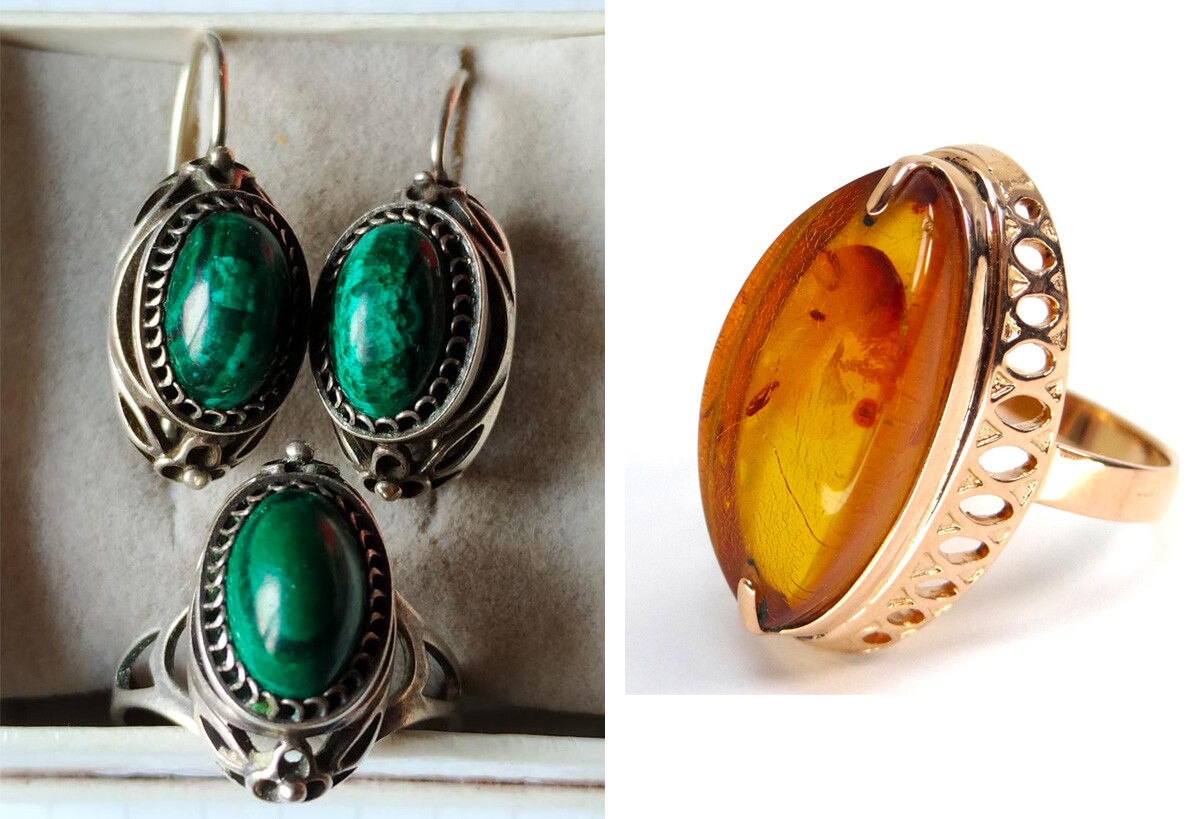
In the 1970s, bright jewelry with large gemstones became mass produced in the USSR. The stones were synthetic, but, despite this, in some families, Soviet jewelry is still passed down from generation to generation.
Nowadays, you can also find stores that sell old Soviet jewels, as well as bijouterie. Strangely enough, they are in demand, not only among collectors. Some still consider Soviet gold to be of the highest quality, while some really like the so-called “grandmotherly” design and the large shimmering stones!
With the rise in living standards in the Soviet Union, starting from the 1960s, gold jewelry with gemstones gained popularity. Truth be told, the stones were artificially grown or synthetic, but they looked almost like the real thing and, sometimes, even better. Soviet scientists successfully synthesized them in laboratories - initially, for the needs of industry. Phianites (aka cubic zirconia), an analogue of the diamond, was used in optical devices, while the synthetic alexandrite and ruby were used to make watches and lasers. Then, the invention spread into the jewelry industry, so that almost every girl had a piece of jewelry set with these stones.
Thanks to synthetic stones, mass production of jewelry was established by the end of the 1970s, but the assortment was not diverse. Models produced by different factories looked identical. For instance, one of the most widespread designs with Phianites was the “raspberry”, with stones of the same size arranged in circles. Such earrings were produced at the Sverdlovsk, Yerevan, Kharkov and other jewelry factories.
Young girls were given smaller and more elegant earrings. One of the most popular models was called ‘tulip’, decorated with an artificial ruby or alexandrite - almost everyone had such a pair. The alternative was gold earrings without stones, decorated with facets.
Among adult jewelry, it was also possible to find items without stones. For example, ‘Sudarushka’ earrings in the form of an inverted kokoshnik and ball-shaped earrings were very popular.
Rings were created in almost the same designs as earrings and were easily matched. A patterned barrel-shaped ring with patterns was called a ‘turban’: you could find one without patterns and they were often used as wedding rings. A diamond-shaped ring was called a ‘centipede’, because of the tiny “legs” on its edges.
The ‘Marquis’ ring was a very trendy model at some point in time; it was similar to a ‘centipede’, but was adorned with a stone. The ‘spider’ ring was its close, and no less popular, competitor. Both rings were produced with stones of different colors.
The height of chic in mass jewelry production was the open-work ‘Shahinya’ ring with a large gem.
Nowadays, such jewelry is not particularly valuable, but, in some families, it is still passed down from generation to generation: “I’m wearing my mother’s ruby ‘spider’ ring right now. My dad gave her this ring shortly after the wedding, my mom took great care of it and now, after my mom had passed away, my dad gave the ring to me. I like it and I wear this family jewel proudly,” user O.K. writes in the comments under a post about Soviet jewelry.
In addition to jewelry with synthetic stones, in access were pieces made of semi-precious stones: malachite, amber, turquoise or coral, with which whole sets were created. Amber was particularly common: in Kaliningrad, which is approximately 1,100 kilometers away from Moscow, about 90% of the world’s reserves of the stone were concentrated and it was mined industrially and supplied to jewelry factories. The products made from amber had the same drawbacks as those made of synthetic stones. All of them looked very much the same. “When I came to Poland for the first time after the collapse of the Soviet Union, I was absolutely stunned by the incredible variety and beauty of amber pieces. Most of the amber was Russian, but small Polish workshops were making absolutely marvelous things out of it and for very little money,” Marina from Moscow shares.

Like rings, pendants were easy to pair with earrings - a lot of designs were duplicated in different types of jewelry.

Beads were more creatively crafted: they were made of transparent and colored glass, as well as natural stones. Some fashionistas mixed several strings and wore them all together, arriving at a kind of “boho-chic”.
Silver bracelets were decorated with carved patterns - they were shaped like ‘barrel’ rings and were adjustable in size.
Soviet brooches were particularly diverse. They were decorated with stones and enamel, but the most popular were brooches made of glass produced by the Czech firm ‘Jablonex’. Multicolored rhinestones imitated precious stones and, sometimes, a special coating was applied on top to create the effect of iridescence.
Dear readers,
Our website and social media accounts are under threat of being restricted or banned, due to the current circumstances. So, to keep up with our latest content, simply do the following:
If using any of Russia Beyond's content, partly or in full, always provide an active hyperlink to the original material.
Subscribe
to our newsletter!
Get the week's best stories straight to your inbox